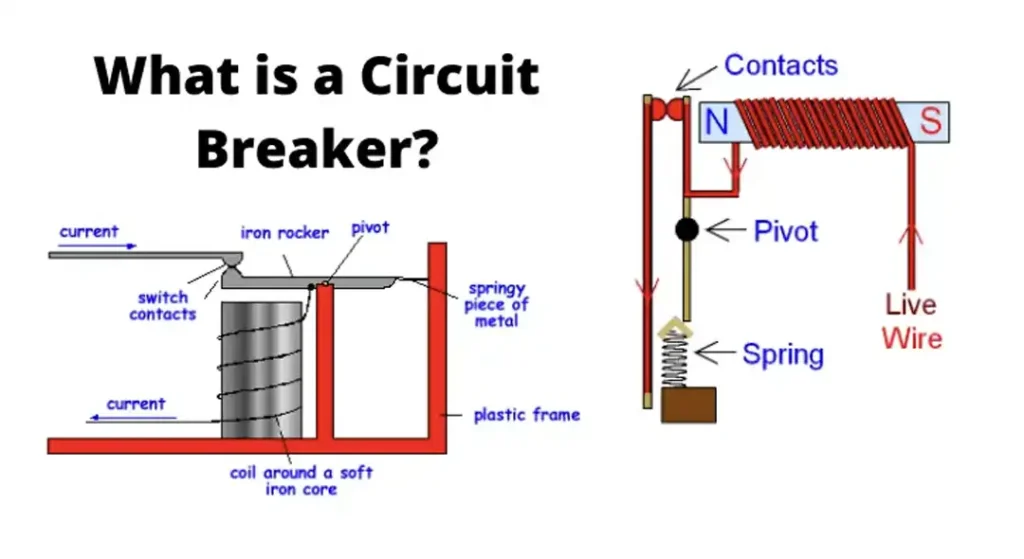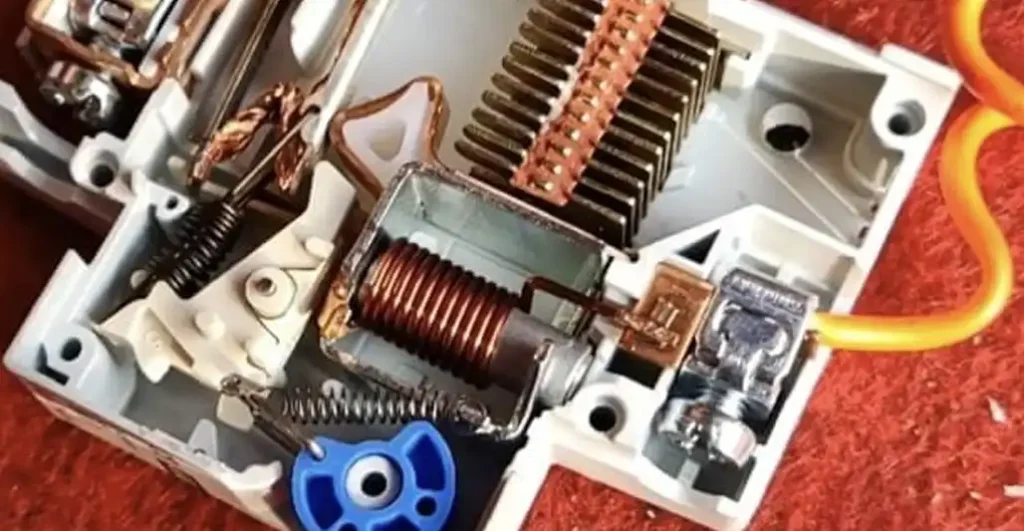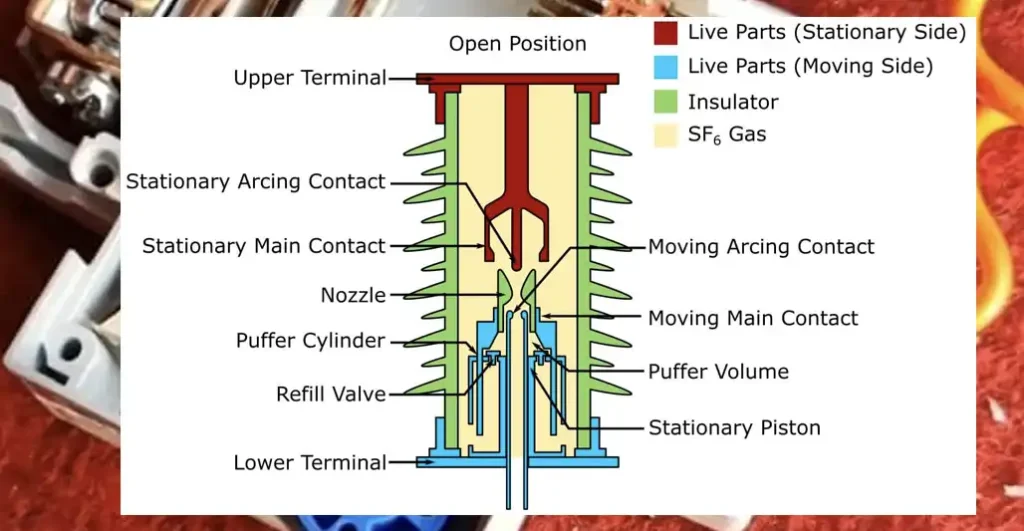In today’s technologically driven world, the importance of safety in electrical systems cannot be overstated. A key component ensuring this safety is the circuit breaker.
This device plays a critical role in protecting electrical circuits from damage caused by overcurrent or short circuits. By automatically interrupting the flow of electricity in hazardous situations, circuit breakers prevent potential fires, equipment damage, and personal injury. Understanding how circuit breakers work is essential for anyone involved in electrical installations or maintenance.
What is Circuit Breaker

A circuit breaker is an essential electrical safety device designed to protect an electrical circuit from damage caused by overcurrent or short circuits. Its primary function is to interrupt the flow of electricity whenever a fault is detected, thereby preventing potential hazards like fires, equipment damage, and personal injury.
Key Functions of a Circuit Breaker:
- Interrupting Fault Current: When an overload or short circuit occurs, the circuit breaker detects the fault and automatically disconnects the electrical flow.
- Manual Control: Circuit breakers can also be manually operated to switch circuits on or off for maintenance or emergency purposes.
- Resettable Protection: Unlike fuses, which need to be replaced after they blow, circuit breakers can be reset and reused after they trip, making them more convenient and cost-effective.
Basic Components of a Circuit Breaker:
- Contacts: These are the conductive elements that open and close to allow or interrupt the flow of current.
- Arc Extinguisher: This component quenches the electrical arc that forms when the contacts open.
- Operating Mechanism: This is the system that moves the contacts to open or close the circuit.
- Trip Unit: This part senses fault conditions and activates the operating mechanism to disconnect the circuit.
Types of Circuit Breakers:
- Miniature Circuit Breaker (MCB): Commonly used in residential and small commercial applications for low voltage circuits.
- Molded Case Circuit Breaker (MCCB): Used in larger commercial and industrial applications where higher current ratings are required.
- Ground Fault Circuit Interrupter (GFCI): Specifically designed to protect against ground faults by interrupting the circuit when it detects an imbalance between the live and neutral wires.
- Arc Fault Circuit Interrupter (AFCI): Protects against arc faults, which are high-energy discharges that can cause fires.
- High-Voltage Circuit Breaker: Used in power transmission and distribution systems to handle very high voltages.
Applications:
Circuit breakers are used in various settings, including:
- Residential: Protecting household wiring and appliances from electrical faults.
- Commercial: Ensuring safe electrical distribution in office buildings, shopping centers, and other commercial facilities.
- Industrial: Safeguarding machinery and equipment in manufacturing plants and other industrial environments.
- Utilities: Managing and protecting the electrical grid in power generation and distribution systems.
Benefits:
- Safety: Prevents electrical fires and protects users from electric shocks.
- Cost-Effectiveness: Reduces repair costs and downtime by preventing damage to electrical equipment.
- Convenience: Easily resettable after tripping, unlike fuses that need replacement.
Technical Specifications
Basic Components of a Circuit Breaker
- Contacts: The conductive elements that open and close to interrupt or allow current flow.
- Arc Extinguisher: A device to quench the electrical arc when the circuit opens.
- Operating Mechanism: The system that moves the contacts.
- Trip Unit: The component that senses fault conditions and activates the operating mechanism.
Types of Circuit Breakers
- Miniature Circuit Breaker (MCB): Typically used for low voltage applications.
- Molded Case Circuit Breaker (MCCB): Suitable for higher power applications.
- Ground Fault Circuit Interrupter (GFCI): Protects against ground faults.
- Arc Fault Circuit Interrupter (AFCI): Protects against arc faults.
- High-Voltage Circuit Breaker: Used in substations and industrial power systems.
Electrical Ratings
- Voltage Rating: The maximum voltage the breaker can handle.
- Current Rating: The maximum current the breaker can carry without tripping.
- Interrupting Capacity: The maximum fault current the breaker can safely interrupt.
Applications
Residential Use
- Protecting Home Wiring: Circuit breakers in homes prevent electrical fires and protect appliances.
- Safety in Wet Areas: GFCIs are crucial in bathrooms and kitchens.
Commercial Use
- Office Buildings: Ensuring safe electrical distribution.
- Data Centers: Protecting sensitive equipment from electrical surges.
Industrial Use
- Manufacturing Plants: Safeguarding heavy machinery and maintaining operational continuity.
- Power Plants: Managing the high power needs and protecting against large-scale failures.
Benefits
Safety Enhancements
- Prevents Fires: By cutting off the power during faults, circuit breakers prevent potential fires.
- Protects Equipment: Reduces the risk of damage to expensive electrical equipment.
- Personal Safety: Minimizes the risk of electrical shocks and injuries.
Efficiency Improvements
- Reduces Downtime: Quick restoration of power by resetting the breaker.
- Cost Savings: Lower repair and replacement costs due to reduced equipment damage.
- Energy Management: Helps in managing and monitoring electrical loads effectively.
How Does Circuit Breaker Work

Circuit breaker how does it work? Here is the detailed explanation that you can look in the following:
A circuit breaker works by detecting fault conditions in an electrical circuit and interrupting the flow of electricity to prevent damage and hazards. Here’s a detailed explanation of how this essential device operates:
Key Components and Their Functions:
Contacts:
- Fixed and Moving Contacts: These are the conductive parts that come together to allow electricity to flow and separate to interrupt the current.
- Opening and Closing: In normal operation, the contacts are closed, allowing current to pass through. When a fault is detected, the contacts open to break the circuit.
Operating Mechanism:
- Mechanical Linkage: This mechanism is responsible for moving the contacts. It can be manually operated (by a switch) or automatically triggered by the trip unit.
- Spring-Loaded System: Typically, a spring mechanism provides the force necessary to quickly open the contacts and interrupt the current flow.
Arc Extinguisher:
- Arc Formation: When the contacts open, an electrical arc forms between them. This arc needs to be extinguished quickly to prevent damage.
- Quenching the Arc: The arc extinguisher uses various methods, such as air, gas, or vacuum, to cool and dissipate the arc, safely breaking the circuit.
Trip Unit:
- Sensing Fault Conditions: The trip unit monitors the current flow and detects abnormal conditions such as overcurrent or short circuits.
- Activation: When a fault is detected, the trip unit activates the operating mechanism to open the contacts and interrupt the current flow.
Types of Trip Units:
Thermal-Magnetic Trip Unit:
- Thermal Element: Uses a bimetallic strip that bends when heated by excessive current, eventually triggering the trip mechanism.
- Magnetic Element: Uses an electromagnet that responds instantly to large surges of current (such as short circuits) by pulling a lever to trip the breaker.
Electronic Trip Unit:
- Microprocessor-Controlled: Uses sensors and a microprocessor to monitor current flow and make precise decisions on when to trip the breaker.
- Programmable Settings: Allows for adjustable settings and more accurate protection based on specific requirements.
Operation Process:
Normal Conditions:
- Current Flow: Under normal conditions, current flows through the circuit breaker contacts without interruption.
- Monitoring: The trip unit continuously monitors the current to detect any deviations from normal operating conditions.
Fault Detection:
- Overload Condition: If the current exceeds the breaker’s rated capacity for an extended period, the thermal element in a thermal-magnetic trip unit will heat up and eventually trip the breaker.
- Short Circuit: If a sudden surge of current occurs, the magnetic element or the electronic sensors detect the fault almost instantaneously and trigger the trip mechanism.
Interruption:
- Contact Separation: The operating mechanism swiftly separates the contacts, creating an electrical arc.
- Arc Quenching: The arc extinguisher rapidly dissipates the arc to ensure the circuit is safely broken.
Resetting the Breaker:
- Manual Reset: After addressing the cause of the fault, the breaker can be manually reset by moving the switch to the ‘ON’ position.
- Automatic Reset (if applicable): Some advanced circuit breakers can reset automatically after a fault is cleared, though manual intervention is more common for safety reasons.
Safety Features:
Selective Tripping:
- Coordination: Circuit breakers are designed to coordinate with each other to ensure that only the breaker nearest to the fault trips, minimizing disruption to the rest of the system.
Indicator Lights:
- Fault Indication: Many modern breakers include indicators or lights that show when a breaker has tripped, helping to quickly identify and address the issue.
A circuit breaker’s primary role is to provide a safety mechanism in electrical systems by detecting faults and interrupting current flow to prevent damage and hazards. Its components work together to ensure that the circuit is interrupted quickly and safely when needed.
Understanding how circuit breakers work helps in selecting, installing, and maintaining these crucial devices to ensure the safety and efficiency of electrical systems.
High Voltage Circuit Breaker Working Principle

High voltage circuit breakers are critical components in power transmission and distribution systems, designed to interrupt and isolate electrical faults to prevent damage to equipment and ensure the reliability of the electrical grid.
The working principle of high voltage circuit breakers involves sophisticated mechanisms and precise control to effectively manage the interruption of high currents and voltages. Here’s an overview of the working principle:
Key Components:
Main Contacts:
High voltage circuit breakers feature robust main contacts capable of withstanding high currents and voltages.
When closed, these contacts allow current to flow through the circuit breaker.
Arc Chute:
As the main contacts open to interrupt the current flow, an arc is formed between them due to the ionization of the air.
The arc chute is designed to rapidly cool and extinguish the arc to prevent damage to the contacts and surrounding components.
Operating Mechanism:
High voltage circuit breakers utilize powerful operating mechanisms to open and close the main contacts.
These mechanisms may include hydraulic, pneumatic, or spring-loaded systems capable of generating the force required to operate the heavy-duty contacts.
Control System:
Sophisticated control systems monitor various parameters such as current, voltage, and temperature to determine when to operate the circuit breaker.
These systems ensure precise coordination and timing of the opening and closing of the contacts to effectively interrupt fault currents.
Trip Coil:
The trip coil is an electromechanical device that generates the force necessary to open the main contacts when a fault is detected.
When energized, the trip coil releases the latch holding the contacts closed, allowing them to open rapidly.
Working Process:
Normal Operation:
During normal operation, the main contacts of the circuit breaker are closed, allowing current to flow through the electrical circuit.
The control system continuously monitors the system parameters to detect any abnormal conditions.
Fault Detection:
When a fault such as a short circuit or overload occurs in the electrical system, the control system detects the fault condition.
Based on the severity and type of fault, the control system initiates the tripping sequence to interrupt the current flow.
Tripping Sequence:
Upon receiving a signal from the control system, the trip coil energizes, releasing the latch holding the main contacts closed.
The operating mechanism rapidly moves the contacts apart, creating a gap and initiating the arc extinction process.
Arc Extinction:
The arc chute facilitates the rapid cooling and deionization of the arc formed between the separating contacts.
By extinguishing the arc, the circuit breaker effectively interrupts the current flow and isolates the faulted portion of the electrical system.
Isolation and Safety:
Once the arc is extinguished and the current is interrupted, the circuit breaker isolates the faulted section of the electrical circuit to prevent further damage.
This isolation ensures the safety of personnel and equipment while allowing the rest of the system to continue operating normally.
Conclusion
Understanding the functionality and importance of circuit breakers is crucial for maintaining electrical safety and efficiency. These devices not only protect against potential hazards but also ensure the smooth operation of electrical systems in various settings. With advancements in technology, the future of circuit breakers promises even greater integration with smart systems and sustainable practices.